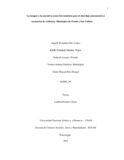Mostrar el registro sencillo del ítem
La imagen y la narrativa como herramienta para el abordaje psicosocial en escenarios de violencia. Municipios de Ocaña y San Calixto
| dc.contributor.advisor | Bermeo Claros, Ludibia | |
| dc.coverage.spatial | cead_-_ocaña | |
| dc.creator | Ascanio Torrado, Nohemí | |
| dc.creator | Ríos Rangel, Yindy Maryud | |
| dc.creator | Gutiérrez Mondragón, Yeimin Andrea | |
| dc.creator | Ortiz López, Angelli Fernanda | |
| dc.creator | Jiménez Trigos, Khelly Fernanda Jiménez | |
| dc.date.accessioned | 2021-12-04T19:30:08Z | |
| dc.date.available | 2021-12-04T19:30:08Z | |
| dc.date.created | 2021-12-03 | |
| dc.identifier.uri | https://repository.unad.edu.co/handle/10596/43843 | |
| dc.description.abstract | El conflicto y la violencia se han convertido en una problema que logra afectar al sujeto de manera biopsicosocial, es decir afecta completamente su contexto desde cualquier ámbito en el que se desarrolle, pues no solo son los daños físicos que se originan a partir del conflicto armado sino también los daños psicológicos y crisis emocionales que surgen después de vivir situaciones dolorosas o episodios donde se ha alterado la tranquilidad del sujeto; de estas experiencias podemos resaltar la subjetividad tomando en cuenta los acontecimientos principales que llevan a la actuación del sujeto. A partir de los relatos trabajados en el desarrollo de esta actividad se ha evidenciado que el conflicto va de la mano con la vulneración de los derechos humanos y es ahí donde se producen impactos psicosociales tanto para el sujeto, como sus familias y comunidades como es el caso del desplazamiento, maltrato físico y psicológico, discriminación, reclutamientos, entre otras situaciones que podemos identificar entre las víctimas que deja el conflicto armado que se vive actualmente en la región. Son muchas las voces que hoy por hoy resaltan el dolor, las memorias de aquellos sujetos que han vivido la violencia, pero aun así muestran comportamientos resilientes donde el sujeto es capaz de superar los episodios donde fueron violados sus derechos de manera directa o indirectamente, saliendo muchas veces de sus zonas residenciales, sus zonas de confort dejando todas sus pertenencias perdidas, encontrando desarraigos totales de sus propiedades, tratando de buscar nuevas alternativas de solución y oportunidades para lograr salir adelante y emprender un futuro mejor para el sujeto propio y su núcleo familiar, llegando a ciudades o pueblos donde existan ONG y entes locales que contribuyan de alguna manera con mitigar las problemáticas y necesidades que tiene la población víctima del conflicto armado, para así de esta manera lograr que estas familias que en muchos casos son desplazados, tengan un mejor inicio en las ciudades o nuevos lugares donde deben empezar de cero y realmente es de admirar al ser humano que sea capaz de aprender a vivir con sus memorias, teniéndolas como anécdotas y nuevos aprendizajes de situaciones por las que tuvieron que pasar por vivir en zonas rojas donde predominan grupos al margen de la ley y fuerza pública. | |
| dc.format | ||
| dc.title | La imagen y la narrativa como herramienta para el abordaje psicosocial en escenarios de violencia. Municipios de Ocaña y San Calixto | |
| dc.type | Curso de Profundización | |
| dc.subject.keywords | Comportamiento resiliente | |
| dc.subject.keywords | Impactos psicosociales | |
| dc.subject.keywords | Memorias | |
| dc.subject.keywords | Subjetividad | |
| dc.description.abstractenglish | Conflict and violence have become a problem that manages to affect the subject in a biopsychosocial way, that is, it completely affects its context from any area in which it develops, since it is not only the physical damage that originates from the armed conflict but also the psychological damages and emotional crises that arise after experiencing painful situations or episodes where the tranquility of the subject has been altered; From these experiences we can highlight the subjectivity taking into account the main events that lead to the subject's performance. From the stories worked on in the development of this activity, it has been shown that the conflict goes hand in hand with the violation of human rights and that is where psychosocial impacts occur both for the subject, their families and communities, as is the case of the displacement, physical and psychological abuse, discrimination, recruitment, among other situations that we can identify among the victims left by the armed conflict that is currently being experienced in the region. There are many voices that today highlight the pain, the memories of those subjects who have experienced violence, but still show resilient behaviors where the subject is able to overcome the episodes where their rights were violated directly or indirectly, leaving many times from their residential areas, their comfort zones leaving all their lost belongings, finding total uprooting of their properties, trying to find new alternative solutions and opportunities to get ahead and start a better future for their own individual and their family nucleus , reaching cities or towns where there are NGOs and local entities that contribute in some way to mitigating the problems and needs of the population victim of the armed conflict, in order to ensure that these families, who in many cases are displaced, have a best start in cities or new places where they must start from scratch and it really is d e admire the human being who is capable of learning to live with their memories, taking them as anecdotes and new learnings of situations that they had to go through living in red zones where groups outside the law and public force predominate. | |
| dc.subject.category | Psicología |















